This topic describes the background information, limitations, procedure, scenarios, and troubleshooting tips for configuring and modifying matching rules for migration or synchronization objects.
Background
When you create a data migration or synchronization task, you must specify the objects to migrate or synchronize. The data transmission service allows you to directly specify objects, import objects, or configure matching rules for objects. You can configure wildcard-based matching rules to specify and modify migration or synchronization objects. You can also configure object mapping logic between the source and the target. This allows you to specify a large number of objects to be migrated or synchronized in a simple and efficient manner. New tables meeting the matching rules can be automatically synchronized to the target through DDL operations for incremental synchronization. For more information, see Supported DDL operations for synchronization and limitations.
Wildcard patterns for data migration/synchronization between databases
The following table describes the wildcard patterns supported by the data transmission service for data migration/synchronization between databases.
In the following table, an asterisk (*) indicates a wildcard.
Two-way synchronization tasks do not support database or table aggregation.
Category | Supported rule | Example | Description |
Direct migration of objects | *.* | kd_test*.person* | All tables whose name starts with person in all databases whose name starts with kd_test are migrated from the source to the target. The source database names and table names remain unchanged. |
*.<source table> | kd_test*.person | All tables named person in all databases whose name starts with kd_test are migrated from the source to the target. The source database names and table names remain unchanged. | |
<source database>.* | kd_test.person* | All tables whose name starts with person in the database named kd_test are migrated from the source to the target. The source database name and table names remain unchanged. | |
<source database>.<source table> | kd_test.person | The table named person in the database named kd_test is migrated from the source to the target. The source database name and table name remain unchanged. | |
Renaming of objects after migration | <source database>.<source table>=<target database>.<target table> | kd_test.person=kd_test_new.person_new | The table named person in the database named kd_test is migrated from the source to the target. The kd_test database is renamed as kd_test_new, and the person table is renamed as person_new. |
<source database>.*=<target database>.* | kd_test.person*=kd_test_new.person* | All tables whose name starts with person in the database named kd_test are migrated from the source to the target. The kd_test database is renamed as kd_test_new, and the source table names remain unchanged. | |
*.<source table>=*.<target table> | kd_test*.person=kd_test*.person_new | All tables named person in all databases whose name starts with kd_test are migrated from the source to the target. The tables are renamed as person_new, and the source database names remain unchanged. | |
Aggregation of objects | <source database>.*=<target database>.<target table> | kd_test.person*=kd_test.person_all | All tables whose name starts with person in the database named kd_test at the source are aggregated to the person_all table in the kd_test database at the target. |
*.<source table>=<target database>.<target table> | kd_test*.person=kd_test_all.person | All tables named person in all databases whose name starts with kd_test at the source are aggregated to the person table in the kd_test_all database at the target. | |
*.*=<target database>.<target table> | kd_test*.person*=kd_test_all.person_all | All tables whose name starts with person in all databases whose name starts with kd_test at the source are aggregated to the person_all table in the kd_test_all database at the target. | |
*.*=<target database>.* | kd_test*.person*=kd_test_all.person* | All tables whose name starts with person in all databases whose name starts with kd_test at the source are aggregated to the kd_test_all database at the target. The source table names remain unchanged. | |
*.*=*.<target table> | kd_test*.person*=kd_test*.person_all | All tables whose name starts with person in all databases whose name starts with kd_test at the source are aggregated to the person_all table in the databases whose name starts with kd_test at the target. The source database names remain unchanged. |
The requirements for matching rules are as follows:
You cannot use wildcards for both database and table names at the target, for example,
kd_test*.person*=kd_test*.person*.If you use wildcards for both the source and target databases, the database expression must be the same for the source and target, indicating direct database migration.
If you use wildcards for both the source and target tables, the table expression must be the same for the source and target, indicating direct table migration.
If you use a wildcard for databases at the target, you must also use a wildcard for databases at the source.
If you use a wildcard for tables at the target, you must also use a wildcard for tables at the source.
Wildcard patterns for data migration/synchronization between a database and a Message Queue instance
The following table describes the wildcard patterns supported by the data transmission service for data migration/synchronization between a database and a Message Queue instance.
In the following table, an asterisk (*) indicates a wildcard.
Supported rule | Example | Description |
*.*=<topic name> | *.*=topic | Multiple tables in multiple databases are mapped to one topic. |
*.<source table>=<topic name> | *.b=topic | The tables named b in multiple databases are mapped to one topic. |
<source database>.*=<topic name> | a.*=topic | Multiple tables in database a are mapped to one topic. |
<source database>.<source table>=<topic name> | a.b=topic | Table b in database a is mapped to a topic. |
Limitations
The data transmission service supports multiple rules. Make sure that each rule is placed in a single row and has no leading or trailing spaces.
Matching rules for migration or synchronization objects must not be empty. Object exclusion rules can be empty.
DDL operations for change are not supported during schema migration and full migration.
When you configure matching rules to select migration or synchronization objects, table names cannot contain line breaks, spaces, or special characters. The special characters are . | " ' ` ( ) = ; / & \ * ? [ ] [ ! ]
You are not allowed to configure multiple matching rules to map different tables in the same database at the source to different databases at the target, for example,
a.a* = b.a* & a.b* = c.b*.In a scenario of database or table aggregation, reverse increment is not supported.
NoteThe data transmission service checks whether database or table aggregation exists only when a data migration or synchronization task is saved or started. The data transmission service does not block database or table aggregation that occurs during the running of a task. However, the mappings between databases or tables may fail to be correctly identified during reverse increment, which compromises the data quality.
At present, the data transmission service does not support the DDL statement CREATE DATABASE. If a new database created at the source meets the object matching rules, you must manually create a corresponding database at the target to continue with the data synchronization of the new database.
Considerations
After you configure object matching rules and exclusion rules, objects that are within the difference set of the object matching and exclusion rules can be selected.
NoteA difference set between two sets contains all elements that exist in one set but do not exist in the other set.
After DDL synchronization is enabled, when you use a DDL statement to create a new table or modify the schema of a table at the source, if the table is within the difference set of the object matching and exclusion rules, this DDL statement can be synchronized to the target by the data transmission service.
Take note of the following considerations if you want to aggregate multiple tables:
We recommend that you configure the mappings between the source and target by specifying matching rules.
We recommend that you manually create schemas at the target. If you create a schema by using the data transmission service, skip the failed objects in the schema migration step.
If you select DDL Synchronization, databases or tables may be dropped by mistake. For example, when multiple databases or tables at the source are aggregated to a single database or table at the target, if a database or table is dropped at the source, the aggregated database or table may be dropped at the target.
When you create a data migration task, click Full Migration and select Ignore for Handle Non-empty Tables in Target Database.
NoteIf you select Ignore, data is pulled in IN mode for full verification. In this case, verification is inapplicable if the target contains data that does not exist in the source, and the verification performance is downgraded.
If a renaming mapping rule is configured for tables, the renaming mapping rule takes precedence. For example, if the rules
a.b[0-3]anda.b[3-5]=a.care configured, thea.b3table is renamed asa.c.When you execute the DDL statement RENAME TABLE, if the renamed table does not meet the original matching or exclusion rule, unexpected synchronization issues may occur. Proceed with caution.
Configure matching rules between databases
Complete the steps before Select Migration Objects or Select Synchronization Objects for a data migration or synchronization task.
For more information, see the topics about data migration or data synchronization tasks of the corresponding data source types.
NoteThe procedure for selecting migration objects is the same as that for selecting synchronization objects. This section describes how to select migration objects.
In data synchronization tasks for synchronizing data from an OceanBase database in MySQL-compatible mode to an AnalyticDB for MySQL database, from an ApsaraDB RDS for PostgreSQL instance to an OceanBase database in Oracle-compatible mode, or between OceanBase databases of the same type, matching rules are configured for selecting synchronization objects between databases.
In the Select Migration Objects section, select Match Rules.

In the Specify Migration Scope section, specify Object Migration Rules and Object Exclusion Rules (optional). For more information, see Wildcard rules.
NoteIf the configured rule contains spaces, the object migration or synchronization project may fail.
Click Verify.
To view the matching results, click Preview Objects after the verification succeeds. The wildcard-based matching rules and exclusion rules apply to tables and views. The matching results are displayed on the Final Objects, New Objects, and Removed Objects tabs.
Tab
Description
Final Objects
Displays the migration objects that are hit by the specified matching rules.
New Objects
Displays the migration objects that are not in the result of the previous matching.
Removed Objects
Displays the migration objects that are only in the result of the previous matching.
After you configure matching rules for selecting migration or synchronization objects, you can set filtering conditions.
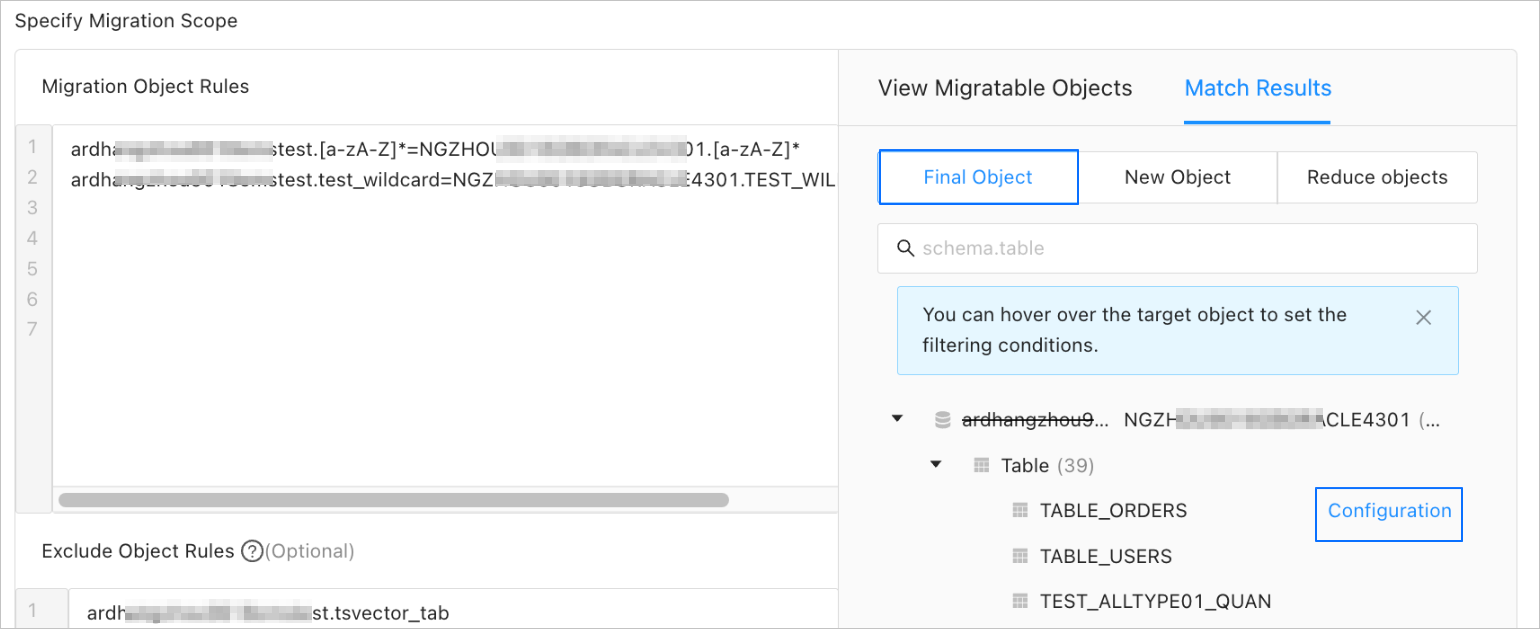
Choose Matching Results > Final Objects and move the pointer over the target table object.
Click Settings.
In the Settings dialog box, specify a standard SQL
WHEREclause to filter data by row. Then, click Validate Syntax. For more information, see Use SQL conditions to filter data.After the syntax validation is passed, click OK.
You can also view column information of the migration objects in the View Columns section.
Complete subsequent task settings as prompted.
Sample scenarios
Direct migration of objects
Migrate all tables whose name starts with test in all databases whose name starts with jenkins_api at the source to the target, and retain the original database and table names. To do so, configure the matching rule as shown in the following figure.
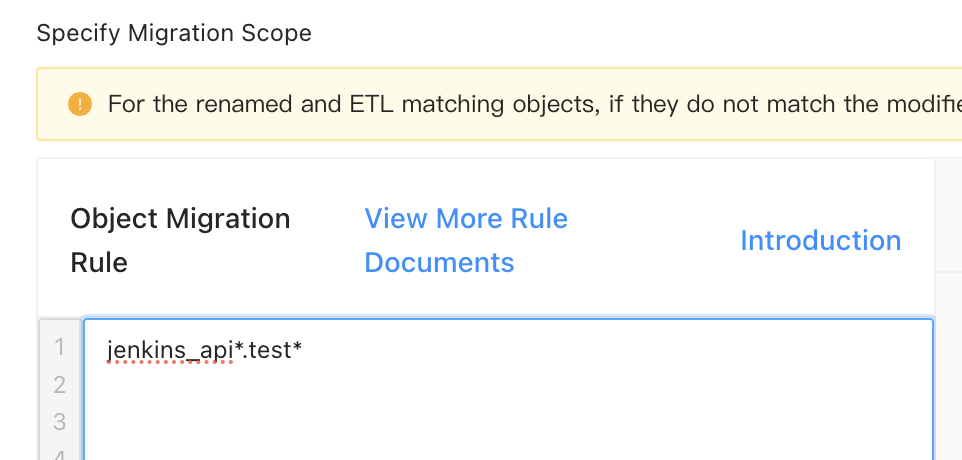
Renaming of objects after migration
Migrate all tables whose name starts with test in the database named jenkins_my2dh_one at the source to the target, rename the jenkins_my2dh_one database as jenkins_my2dh_one_new, and retain the original table names. To do so, configure the matching rule as shown in the following figure.
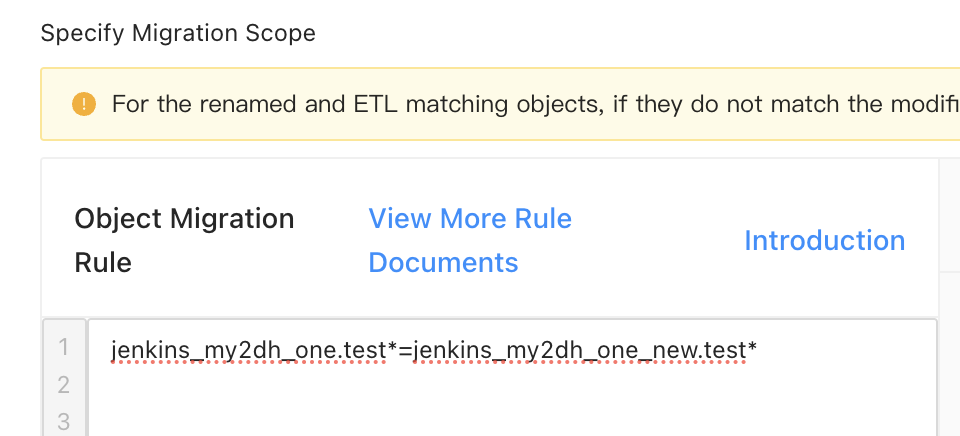
Aggregation of objects
Aggregate all tables whose name starts with order in all databases whose name starts with jenkins_api at the source to the order table in the jenkins_api_all database at the target. To do so, configure the matching rule as shown in the following figure.
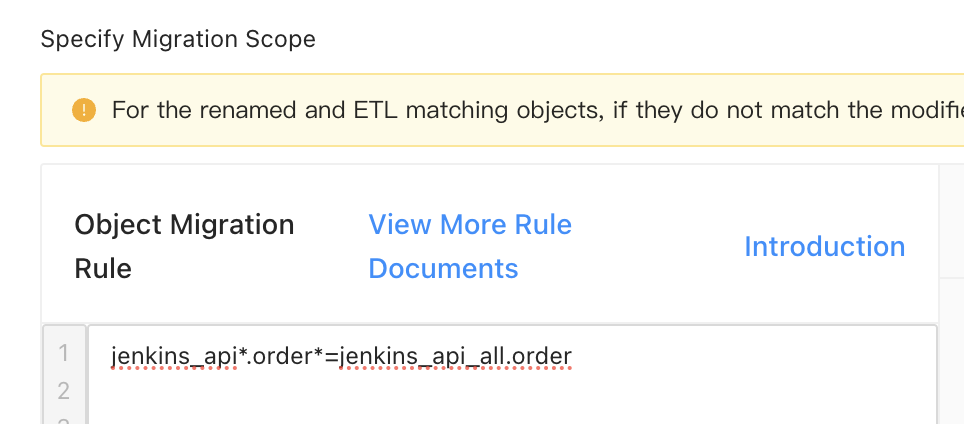
Configuration of object exclusion rules
Exclude historical tables whose name starts with history_ and log tables whose name ends with log in the jenkins_api_mysql56 database at the source from migration. To do so, configure the matching rule as shown in the following figure.
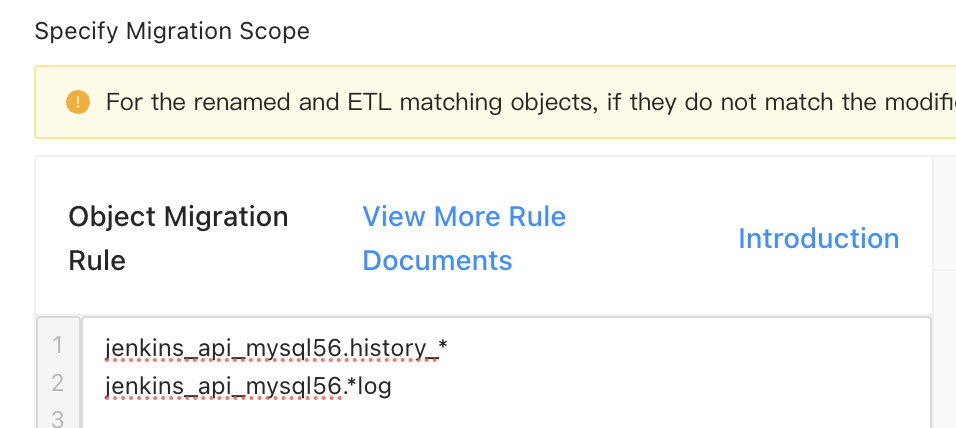
Modify matching rules between databases
Rule description
You cannot add migration objects for a data migration task in the reverse increment phase.
You cannot add migration objects when you migrate data from a PolarDB-O database to an OceanBase database in Oracle-compatible mode.
The following table describes the scenarios where matching rules can be modified.
Data migration phase
Migration task status
Phase status
/
Not Started
/
Full migration
Running
Running
Failed
Failed
Stopped
Stopped
Incremental synchronization/Reverse increment
Running
Running
Running
Monitoring
Failed
Failed
Stopped
Stopped
Procedure
Go to the View Objects dialog box.
Log on to the
ApsaraDB for OceanBase console.In the left-side navigation pane, choose Data Transmission > Data Migration.
On the Data Migration page, click the name of the target task to go to its details page.
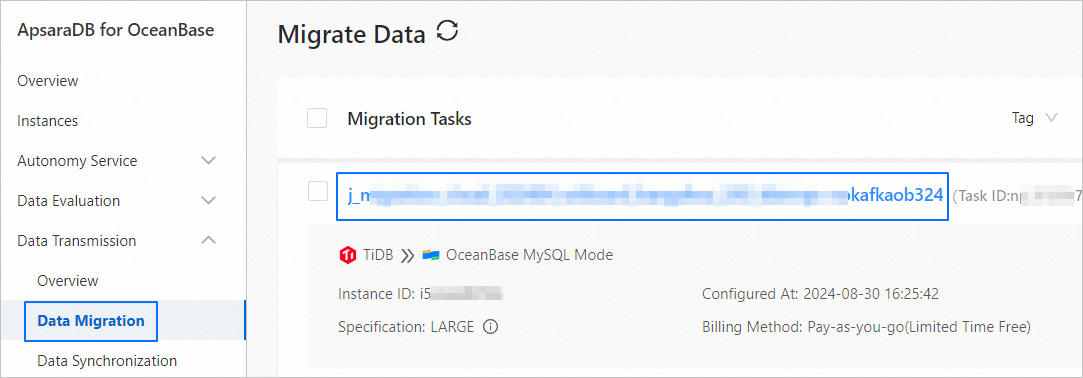
Click View Objects in the upper-right corner. The migration objects and modification records are displayed.
In the View Objects dialog box, click Modify Rules in the lower-right corner.

In the Modify Rules dialog box, modify the matching rules for migration objects to add or remove the objects.
Click Verify. To view the matching results, click Preview Objects after the verification succeeds.
You can hover the pointer over a new object and click Configuration that appears to configure the filter conditions of this object.

Click Next.
When you add objects, the system performs a precheck on these objects.
When you remove objects, the number of objects to be removed is displayed.
Click Submit after the precheck succeeds or you have confirmed the number of objects to be removed.
After the object modification is executed, you can click View Objects in the upper-right corner of the page and click Modified records to view the modification records and details.

Configure matching rules for data migration/synchronization from a database to a Message Queue instance
When you synchronize data from an OceanBase database to a DataHub, Kafka, or RocketMQ instance, you can configure matching rules to select the objects to synchronize.
Create a data synchronization task and proceed to the Select Synchronization Objects step as prompted.
For more information, see the topics about data synchronization tasks of the corresponding data source types.
In the Select Synchronization Objects section, select Match Rules.

Specify Object Synchronization Rules and Object Exclusion Rules (optional). For more information, see Wildcard patterns supported for matching rules.
When you configure matching rules, the business logic varies with the type of the data synchronization task.
If the target is a DataHub instance, the topic type can be Tuple or BLOB.
For the Tuple type, you can enter only existing topic names without wildcards or spaces. After you select tables, they are mapped to topics in a one-to-one manner.
For the BLOB type, many-to-one and one-to-one mapping methods are supported, and no spaces are allowed.
If you have selected Schema Synchronization when you specified the synchronization type, you can choose to enter the name of an existing topic or create a new topic. Only one mapping method is supported. You can select only one mapping method for creating or selecting topics. If you did not select Schema Synchronization when you specified the synchronization types, you can enter only the name of an existing topic.
If the target is a Kafka or RocketMQ instance, many-to-one and one-to-one mapping methods are supported, and no spaces are allowed.
If you have selected Schema Synchronization when you specified the synchronization types, you can choose to enter the name of an existing topic or create a new topic. If you did not select Schema Synchronization when you specified the synchronization types, you can enter only the name of an existing topic.
Click Verify.
To view the matching results, click Preview Objects after the verification succeeds. The matching results are displayed on the Final Objects, New Objects, and Removed Objects tabs.
After you configure matching rules to select synchronization objects, you can set filtering conditions.

Choose Matching Results > Final Objects and move the pointer over the target table object.
Click Settings.
In the Settings dialog box, you can perform the following operations:
In the Row Filters section, specify a standard SQL
WHEREclause to filter data by row. Then, click Validate Syntax. For more information, see Use SQL conditions to filter data.Select the sharding columns that you want to use from the Sharding Columns drop-down list. You can select multiple fields as sharding columns. This parameter is optional.
Unless otherwise specified, select the primary keys as sharding columns. If the primary keys are not load-balanced, select load-balanced fields with unique identifiers as sharding columns to avoid potential performance issues. Sharding columns can be used for the following purposes:
Load balancing: Threads used for sending messages can be recognized based on the sharding columns if the target table supports concurrent writes.
Orderliness: The data transmission service ensures that messages are received in order if the values of the sharding columns are the same. The orderliness specifies the sequence of executing DML statements for a column.
In the Select Columns section, select the columns to be synchronized. For more information, see Column filtering.
Click OK.
Complete subsequent task settings as prompted.
Modify matching rules for data migration/synchronization from a database to a Message Queue instance
Go to the View Objects dialog box.
Log on to the
ApsaraDB for OceanBase console.In the left-side navigation pane, choose Data Transmission > Data Synchronization.
On the Data Synchronization page, click the name of the target task to go to its details page.

Click View Objects in the upper-right corner. The synchronization objects and modification records are displayed.
In the View Objects dialog box, click Modify Rules in the lower-right corner.

In the Modify Rules dialog box, modify the matching rules for synchronization objects to add or remove the objects.
When you configure matching rules, the business logic varies with the types of data synchronization tasks. For more information, see the "Configure matching rules for data migration/synchronization from a database to a Message Queue instance" section in this topic.
Click Verify. To view the matching results, click Preview Objects after the verification succeeds.
You can hover the pointer over a new object and click Configuration that appears to configure the filter conditions of this object.

Click Next.
When you add objects, the system performs a precheck on these objects.
When you remove objects, the number of objects to be removed is displayed.
Click Submit after the precheck succeeds or you have confirmed the number of objects to be removed.
After the object modification is executed, you can click View Objects in the upper-right corner of the page and click Modified records to view the modification records and details.

FAQ
Insufficient privilege
Pay attention to the privilege settings of the source database user. If you do not grant all required privileges to the migration user, some objects are not displayed in the frontend by the data transmission service, and you cannot correctly configure matching rules. In this case, you must add these objects to Object Exclusion Rules to prevent the data migration or synchronization task from being interrupted because the data transmission service cannot find the target objects.
DML filtering unsupported
If DDL synchronization is disabled, the data transmission service allows you to select objects based on matching rules. If a new table created during incremental synchronization meets a matching rule, the related DDL statements will be ignored but the data transmission service will continue to synchronize DML statements. As a result, the data migration or synchronization task will be interrupted because objects cannot be migrated or synchronized to the target. Therefore, you must create the table at the target or add the table to the blocklist.